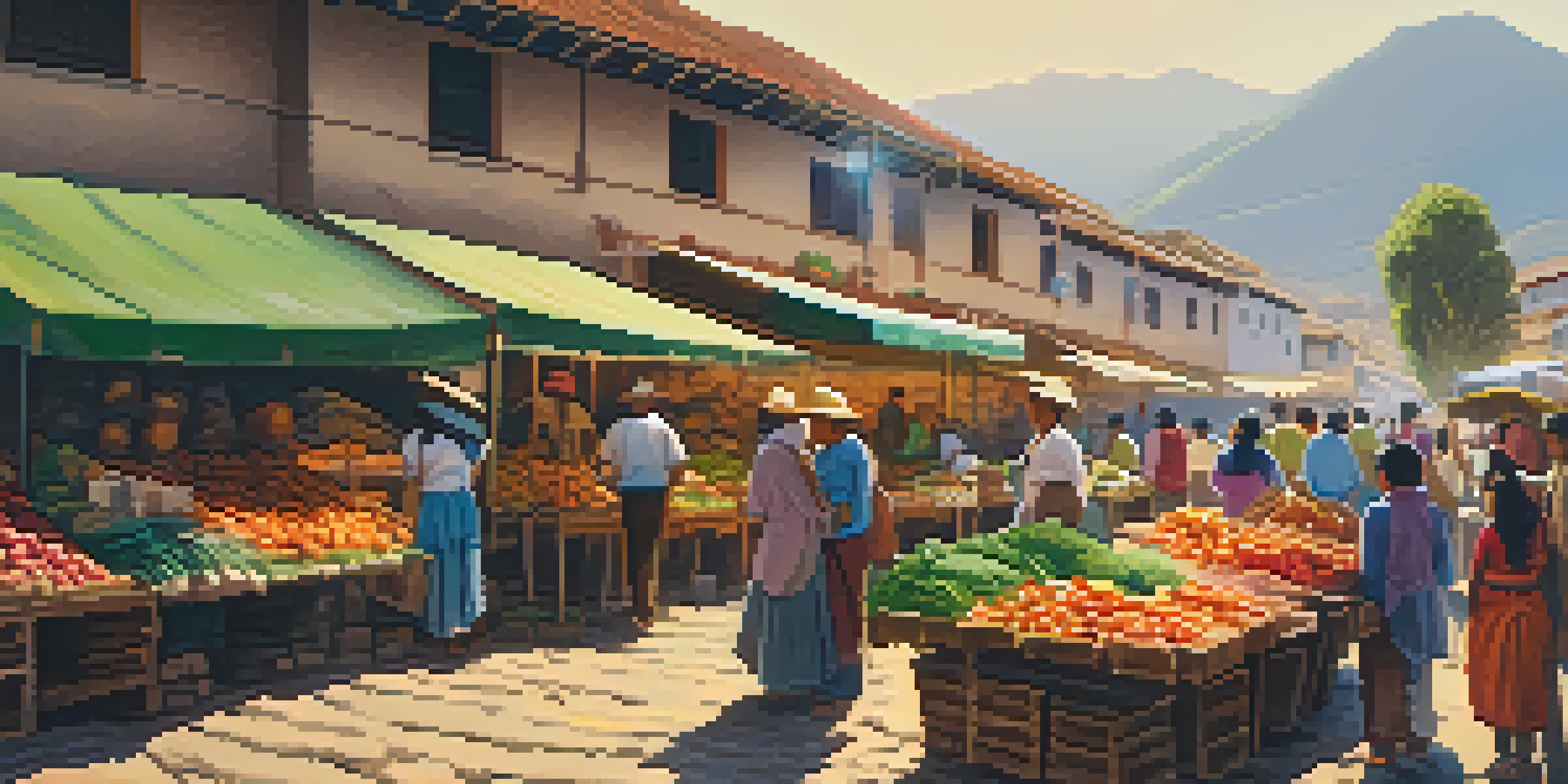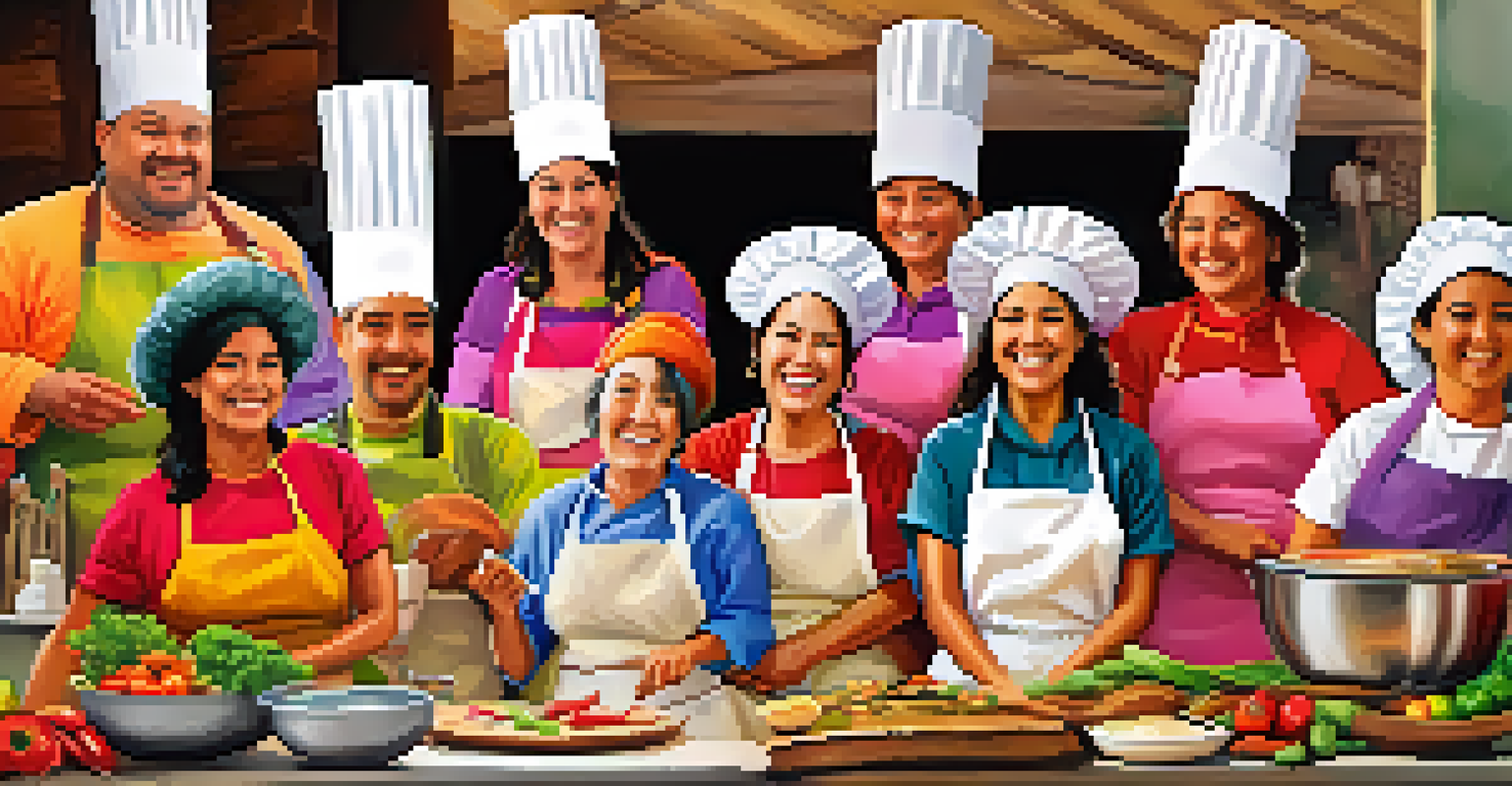Sustainable Culinary Tourism: Tasting Peru's Local Flavors

Understanding Sustainable Culinary Tourism
Sustainable culinary tourism blends travel with a commitment to local traditions and the environment. It encourages tourists to explore food experiences that are not only delicious but also eco-friendly. This type of tourism supports local economies while preserving cultural heritage, making it a win-win for travelers and communities alike.
Traveling – it leaves you speechless, then turns you into a storyteller.
Imagine savoring a dish made from ingredients sourced directly from nearby farms. This not only enhances the flavor but also ensures that your dining experience is rooted in the local ecosystem. By choosing sustainable culinary options, tourists can enjoy authentic flavors while contributing to the preservation of the environment.
In Peru, this concept is particularly vibrant, with its rich agricultural diversity and culinary heritage. From the Andes to the Amazon, every region boasts unique ingredients and cooking techniques that reflect the local culture. Embracing sustainable culinary tourism allows you to immerse yourself in these traditions while promoting responsible travel.
The Rich Tapestry of Peru's Culinary Heritage
Peruvian cuisine is a melting pot of influences, with indigenous, Spanish, African, and Asian flavors coming together to create unique dishes. This diversity not only makes the food exciting but also tells the story of the country's history and culture. Each meal is like a journey through time, reflecting the traditions of the people who call Peru home.

For instance, the famous dish ceviche showcases fresh fish marinated in citrus, with roots tracing back to ancient coastal civilizations. It's a perfect example of how local ingredients are celebrated. When you choose to dine on traditional Peruvian food, you’re not just tasting flavors; you're experiencing a narrative that has evolved over centuries.
Sustainable Culinary Tourism Benefits All
This tourism model supports local economies and preserves cultural heritage while offering travelers authentic food experiences.
By supporting local restaurants and chefs who prioritize traditional cooking methods and local ingredients, travelers can help sustain this rich culinary heritage. This creates a ripple effect, encouraging more chefs to preserve their cultural roots and share their stories through food.
Local Ingredients: The Heart of Peruvian Cuisine
Peru is blessed with an incredible variety of ingredients, many of which are unique to the region. From the vibrant colors of native potatoes to the aromatic herbs found in the Amazon, these ingredients are the backbone of Peruvian cooking. Choosing to eat locally not only supports farmers but also enhances your culinary experience.
Food is our common ground, a universal experience.
Consider the quinoa, a superfood that has been cultivated in the Andes for thousands of years. It's a staple ingredient in many dishes and is rich in nutrients. By incorporating such ingredients into your meals, you’re not only enjoying their health benefits but also honoring the agricultural practices that have sustained communities for generations.
Embracing local ingredients also means you’re likely to encounter seasonal dishes, which can vary throughout the year. This connection to the land and its cycles makes each dining experience unique, allowing you to taste the freshness of what Peru has to offer.
Experiencing Culinary Tours in Peru
One of the best ways to explore sustainable culinary tourism in Peru is through culinary tours. These experiences often include visits to local markets, cooking classes, and tastings at family-owned restaurants. Not only do they provide an opportunity to taste authentic dishes, but they also foster connections with local chefs and farmers.
For example, participating in a market tour in Cusco allows you to see where ingredients are sourced and learn about their significance in traditional dishes. Engaging with local vendors can deepen your appreciation for the food you’re about to enjoy. This firsthand experience adds layers to your understanding of Peruvian cuisine.
Local Ingredients Enhance Dining
Peruvian cuisine thrives on unique local ingredients, providing not only exceptional flavors but also a connection to the region's agricultural practices.
Cooking classes can further enhance your journey, as you get hands-on experience preparing local dishes. This immersive approach not only equips you with new recipes to take home but also creates lasting memories tied to the flavors of Peru.
The Role of Community-Based Tourism
Community-based tourism plays a vital role in promoting sustainable culinary tourism. This approach focuses on involving local communities in the tourism process, ensuring that they benefit directly from visitors. By participating in these initiatives, travelers can experience authentic cultural exchanges while supporting local economies.
In Peru, many communities have embraced this model, offering culinary experiences that highlight their traditional practices. For instance, you might find a family-run restaurant that prepares meals using age-old recipes passed down through generations. This not only provides you a taste of genuine Peruvian hospitality but also empowers locals to share their culture.
By choosing community-based tourism options, you're contributing to the preservation of local customs and traditions. You become part of a larger movement that values sustainability and supports the livelihoods of those who make Peru's culinary scene so vibrant.
Sustainable Practices in Peruvian Cuisine
Sustainability in Peruvian cuisine goes beyond just sourcing local ingredients; it also encompasses environmentally friendly practices. Many chefs and restaurants are adopting methods that minimize waste and utilize sustainable practices in their kitchens. This commitment not only enhances the dining experience but also contributes to the health of the planet.
For example, some restaurants in Lima focus on nose-to-tail cooking, where every part of the animal is used to reduce waste. This approach not only makes the most of the ingredients but also showcases the creativity of chefs in creating delicious dishes from what might typically be overlooked.
Community-Based Tourism Empowers Locals
Engaging in community-based culinary experiences fosters authentic cultural exchanges and directly benefits local communities.
Additionally, many establishments are now engaging in practices like composting and using biodegradable packaging. By supporting these restaurants, you’re not just enjoying delicious food; you’re also endorsing a movement towards more responsible culinary practices.
Embracing a Sustainable Culinary Journey
As you embark on your culinary adventure in Peru, remember that every meal can be a step towards sustainability. By choosing to support local businesses and partake in community-focused experiences, you contribute to the preservation of Peru’s rich culinary heritage. Each bite you take is not just a taste; it's a connection to the land and its people.
Think of your travel choices as a way to vote with your fork. When you opt for dishes that celebrate local ingredients and traditions, you're encouraging the continuation of these practices. The more travelers embrace sustainability, the more it becomes a norm within the culinary tourism industry.

Ultimately, sustainable culinary tourism in Peru is about more than just the food; it’s about creating lasting connections, fostering cultural appreciation, and ensuring that future generations can enjoy the same vibrant flavors and traditions.